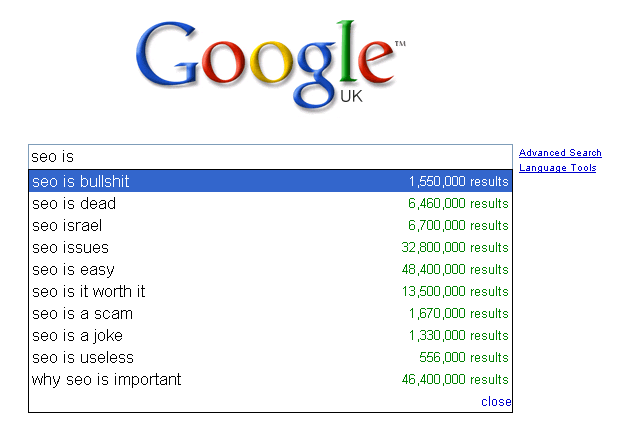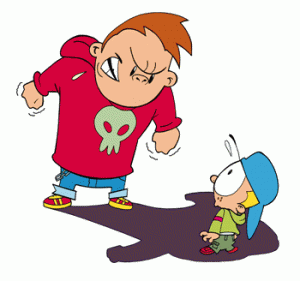Published: November 27th, 2009

Google's automatic suggestion tool shows the extent of the problem
James, Blueclaw’s Director of Paid Search, stumbled across this yesterday and took a screenshot. It shows that SEO still has a real image problem - though at least we’re saved at the end!
Published: November 26th, 2009
As most reputable SEO companies stress; search engine rankings cannot be guaranteed. So, in the (hopefully unlikely) event that a campaign heads south and you don’t gain that first page listing, you need to make sure it has actually held some value for your client.
And if you strive to ensure that this is the case for every campaign, then the successful ones will prove to be even more valuable than simply high rankings.
As I have stated many times, SEO has grown into a fully fledged part of the marketing mix – it has had to in order to keep up with the constantly evolving algorithms. You can no longer trick a search engine into advancing your position. Therefore, with the methods that are now needed in order to be successful, it should not be hard to see that results can be measured far beyond rankings.

Do you offer valued 'inputs' for your 'input payments'?
A campaign that is targeted and implemented correctly using ‘white hat’ methods can dramatically and positively increase brand awareness, regardless of the achieved positions in the search engine results pages. A well thought out social media strategy can positively impact on brand loyalty. And a clever onsite strategy can increase conversions, meaning that even if the highest rankings are not reached, every visitor is likely to be worth more.
These possibilities should be in the forefront of your mind when planning a campaign. After all, an algorithm can change tomorrow, leaving your client searching for any benefits they can find for hiring an SEO company. A campaign that is based on general marketing practices will make these benefits easy to see. And successful campaigns will usually exceed initial expectations!
Published: November 23rd, 2009
Here are some Wordpress plugins that you should have if you’re interested in SEO.
(Not all are strictly directly SEO-related but the ones that aren’t can still help you gain a wider readership; gaining natural links and increasing your blog’s usefulness as an SEO tool!)
Published: November 18th, 2009
The topic of the day on the office radio is not the flooding that has prevented one of my colleagues from reaching work. Oh no. It is the question of whether or not a ‘help’ button should be added to Facebook and Myspace in order to prevent online bullying for children. So why is this topic so important?
Well, according to i-safe, 42% of children in America have been bullied whilst online (I couldn’t easily find any statistics for the UK - though interestingly a page titled ‘where is all the UK bullying statistics’ ranked quite high up in the SERPs, but that’s another blog post!) so the issue seems to be prevalent in many young lives.
The debate is therefore: would the addition of a ‘help’ button reduce this percentage?
My view is…well…no, probably not. The belief that a ‘help’ button would prevent bullying rests upon the belief that children would use it. I’m not so sure this is the case. Research on bullying over the years has shown that the majority of victims are too scared to get help for fear of making bullying worse. And the internet is a bigger place than the playground, where anonymity rules and children access a range of social networking tools. The fear of making it worse is still very real in the virtual world.

Is online bullying any different?
However, as mentioned in many reports, the button is very small and it can’t harm to add it, even it only prevents/aids a very small number of cases. One life saved or one happy child should be worth a small amount of screen space.
My warning is that those that expect it to work miracles are making a distinction between online and offline bullying culture that doesn’t exist. Offline, the victim is often too scared to tell their teacher, parents, the police. Would a help button somewhere in the playground make any difference?
Published: November 6th, 2009
Most people get into SEO by through necessity; by trying to push their own site up the rankings with little or no budget. Hence this is why many become obsessed with onsite factors – something they can learn and do without spending much money. For many, going out into worldwide web, spreading the word and getting those links seems far too much like hard work.
However, there’s no way around it. Learning the tricks of getting links is the most important thing you need to know when doing the SEO for a site by yourself.
I could give you examples of how to email people in order to do this etc. et.c, but it’s pointless me telling you. I’ve seen these tips given out (such as using a made-up girl’s name!) and now they don’t work as everyone is doing them. You have to find what works for you by experimenting. The only advice I can give you is to try and be original. The best way to do this is though making your request personal and relevant.
The same goes for blog comments or forum posts. Be original, sincere and relevant. Then the chances of your point of view being deleted as spam are much slimmer.
The key also is not to feel overwhelmed – link building is not an impossible task. To build, you have to do so block by block. If you set yourself a target of 2 or 3 links a day and just keep chipping away then you can still make a good contribution to optimising a site.


